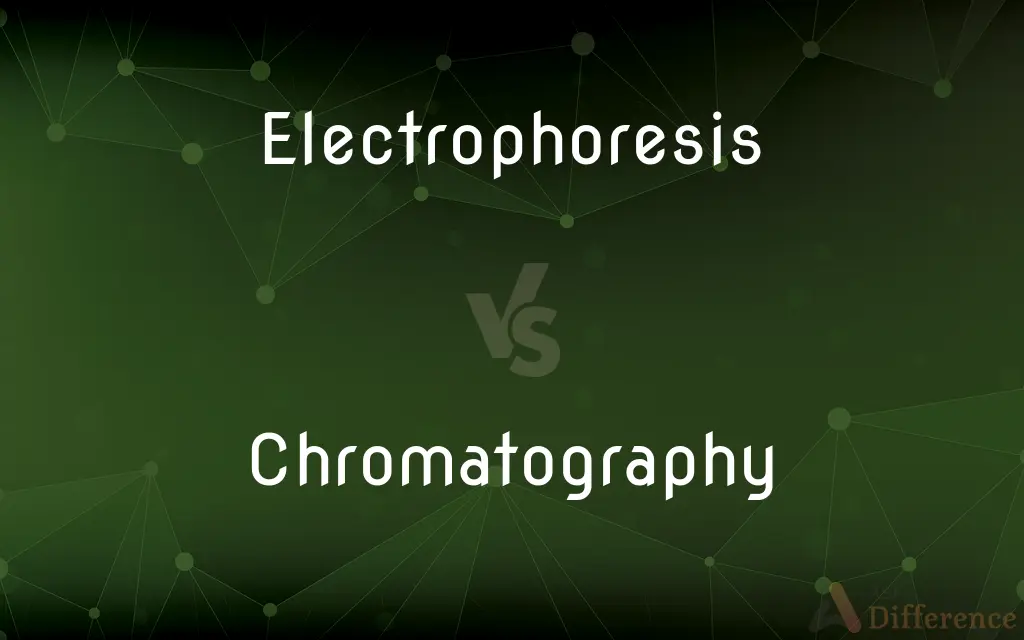Electrophoresis vs. Chromatography — What's the Difference?
By Tayyaba Rehman — Updated on November 3, 2023
Electrophoresis separates molecules by electric charge, while chromatography does so by interaction with a stationary phase.

Difference Between Electrophoresis and Chromatography
Table of Contents
ADVERTISEMENT
Key Differences
Electrophoresis is a technique that applies an electric field to move and separate charged particles, such as DNA, based on size and charge. Chromatography, on the other hand, is a method for separating compounds based on differential partitioning between a mobile phase and a stationary phase. Each technique capitalizes on distinct physical properties for separation.
While electrophoresis predominantly separates biological molecules within an agarose or polyacrylamide gel, chromatography can use liquids or gases as mobile phases across solid or viscous stationary phases. Electrophoresis generally visualizes the end result with staining methods, whereas chromatography often uses detectors for real-time analysis.
Electrophoresis typically involves a uniform medium that can impede the movement of molecules depending on their size and shape, leading to separation. Chromatography relies on the selective adsorption of substances to a stationary phase or their solubility in a solvent, separating compounds based on their chemical properties.
In electrophoresis, the end goal is often to analyze the genetic material or proteins, requiring the interpretation of bands on a gel. Chromatography, meanwhile, is employed in various industries for purifying chemicals, testing food and environmental samples, and even in the pharmaceutical industry for drug development.
The choice between electrophoresis and chromatography will depend on the specific molecules being studied and the purpose of the separation. Electrophoresis is essential for genetic and protein research, whereas chromatography is versatile, used in analytical chemistry, biochemistry, and even industrial processes.
ADVERTISEMENT
Comparison Chart
Basis of Separation
Electric charge and molecule size
Interaction with stationary phase and mobile phase
Typical Medium
Gel (agarose or polyacrylamide)
Liquid, gas, or solid stationary phase
Applied Sciences
Molecular biology, genetics, biochemistry
Analytical chemistry, pharmaceuticals, environmental
Visualization
Staining and UV illumination
Detectors (UV, RI, MS, etc.)
Sample State
Primarily biological molecules (nucleic acids, proteins)
Varied (organic compounds, gases, ions)
Compare with Definitions
Electrophoresis
Electrophoresis utilizes an electric field to migrate charged particles through a medium.
Electrophoresis was crucial for analyzing the patient's protein sample.
Chromatography
Chromatography operates based on differential absorption.
Using chromatography, the lab technician was able to identify all the amino acids in the sample.
Electrophoresis
Electrophoresis can resolve complex mixtures into their components.
The researchers detected the enzyme deficiency after electrophoresis of the tissue extract.
Chromatography
Chromatography involves passing a mixture through a stationary phase.
The new fragrance was perfected using chromatography to separate its constituents.
Electrophoresis
Electrophoresis is instrumental in DNA sequencing and fingerprinting.
The criminal case was solved using electrophoresis to match DNA samples.
Chromatography
Chromatography is a method for separating components of a mixture.
Chromatography revealed the presence of several pollutants in the water sample.
Electrophoresis
Electrophoresis is a lab technique for separating molecules by size and charge.
During the electrophoresis, the DNA fragments sorted themselves by length across the gel.
Chromatography
Chromatography is critical in chemical analysis and research.
Chromatography plays a key role in ensuring food safety by detecting contaminants.
Electrophoresis
Electrophoresis (from the Greek "ηλεκτροφόρηση" meaning "to bear electrons") is the motion of dispersed particles relative to a fluid under the influence of a spatially uniform electric field. Electrophoresis of positively charged particles (cations) is sometimes called cataphoresis, while electrophoresis of negatively charged particles (anions) is sometimes called anaphoresis.
Chromatography
Chromatography is a laboratory technique for the separation of a mixture. The mixture is dissolved in a fluid (gas or solvent) called the mobile phase, which carries it through a system (a column, a capillary tube, a plate, or a sheet) on which is fixed a material called the stationary phase.
Electrophoresis
The migration of charged colloidal particles or molecules through a stationary medium under the influence of an applied electric field usually provided by immersed electrodes. Also called cataphoresis.
Chromatography
Any of various techniques for the separation of complex mixtures that rely on the differential affinities of substances for a mobile (gas or liquid) medium and for a stationary adsorbing (liquid or solid) medium through which they pass, such as paper, gelatin, or silica.
Electrophoresis
A method of separating substances, especially proteins, and analyzing molecular structure based on the rate of movement of each component in a colloidal suspension while under the influence of an electric field.
Chromatography
(analytical chemistry) Any of various techniques for the qualitative or quantitative separation of the components of mixtures of compounds; all characterised by the use of a mobile phase (gas or liquid) moving relative to a stationary phase (liquid or solid) – the differences between the rates of migration of the compounds between the two phases effects the separation.
Electrophoresis
(electricity) the migration of electrically charged molecules through a medium under the influence of an electric field
Chromatography
A treatise on colors
Electrophoresis
(analytical chemistry) (biochemistry), a method for the separation and analysis of large molecules (such as proteins) by migrating a colloidal solution of them through a gel; gel electrophoresis
Chromatography
An analytical and preparative technique for separating substances by differences in their selective adsorption to solids, by passing a liquid over the solid, to which the substances to be separated have usually been adsorbed in a preliminary step. The major variations are column chromatography, in which the substances to be separated are adsorbed to a column with any of a wide variety of adsorbing solids in powdered or granulated form; paper chromatography, in which the solids are applied as a spot at one end of a strip of absorbent paper (such as filter paper), and the liquid is percolated through the paper by capillary action; and thin-layer chromatography (TLC), which is similar to paper chromatography, but the adsorbent material is, instead of paper, a thin layer of finely powdered material, such as cellulose or silica, on a backing of glass or plastic, called a TLC plate. A modern version of column chromatography is high-performance liquid chromatography, usually referred to as HPLC.
Electrophoresis
The motion of charged molecules or particles in a liquid medium under the influence of an electric field; particles with a positive charge move toward the cathode and negative to the anode.
Chromatography
A process used for separating mixtures by virtue of differences in absorbency
Electrophoresis
The application of the principle of electrophoresis to separate molecules, used as an analytical or preparative technique; as, separation by electrophoresis; gel electrophoresis.
Chromatography
Chromatography can purify substances for further use.
Pharmaceutical grade drugs are often purified using chromatography techniques.
Electrophoresis
The motion of charged particles in a colloid under the influence of an electric field; particles with a positive charge go to the cathode and negative to the anode
Electrophoresis
Electrophoresis is used in laboratories for biomolecule separation.
The electrophoresis gel showed clear bands representing different RNA molecules.
Common Curiosities
Is chromatography only used for separation?
Chromatography separates components but can also help in identifying and quantifying them.
What's the main difference between gel electrophoresis and paper chromatography?
Gel electrophoresis uses electric fields on gels, while paper chromatography uses capillary action on paper.
Can electrophoresis be quantitative?
Yes, with proper standards, electrophoresis can be used for quantitative analysis.
Does electrophoresis require a buffer system?
Yes, an appropriate buffer is necessary to maintain pH and conductivity during electrophoresis.
Can electrophoresis separate any type of molecule?
Electrophoresis is best for charged biological molecules, not all molecule types.
Can chromatography analyze gases?
Yes, gas chromatography is specifically designed for analyzing volatile substances.
What is the role of the stationary phase in chromatography?
It selectively impedes different components to aid in their separation.
What does the term "mobile phase" refer to in chromatography?
It's the solvent that carries the sample through the stationary phase.
What is electrophoresis primarily used for?
Electrophoresis is used for separating DNA, RNA, or protein molecules for analysis.
Are there automated systems for chromatography?
Yes, there are many automated systems for different forms of chromatography.
How do I choose between electrophoresis and chromatography?
The choice depends on the type of sample and the analysis goals.
What types of chromatography are there?
Common types include liquid, gas, paper, and thin-layer chromatography.
Are there different types of electrophoresis?
Yes, including agarose gel, polyacrylamide gel, and capillary electrophoresis.
What safety precautions are necessary for electrophoresis?
Avoiding exposure to the electric current and toxic chemicals used is crucial.
Can I use chromatography to purify proteins?
Yes, chromatography is widely used for protein purification.
Share Your Discovery

Previous Comparison
Poll vs. Survey
Next Comparison
Bork vs. HorkAuthor Spotlight
Written by
Tayyaba RehmanTayyaba Rehman is a distinguished writer, currently serving as a primary contributor to askdifference.com. As a researcher in semantics and etymology, Tayyaba's passion for the complexity of languages and their distinctions has found a perfect home on the platform. Tayyaba delves into the intricacies of language, distinguishing between commonly confused words and phrases, thereby providing clarity for readers worldwide.














































